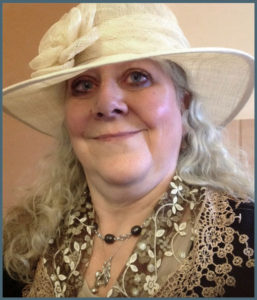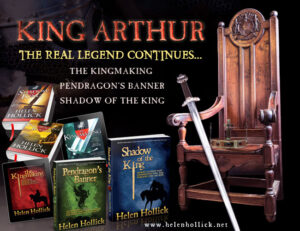 This week’s guest is one making a very welcome return. Helen Hollick is a multi-published author and indie advocate. She lives on a 13 acre 18th century farm in North Devon, with a variety of pets and her family. For over twenty years, she has delighted readers with stories of Arthur Pendragon, Saxon kings and queens, the Norman Conquest and roughish pirates. She doubts she will ever find the time – or inclination – to retire.
This week’s guest is one making a very welcome return. Helen Hollick is a multi-published author and indie advocate. She lives on a 13 acre 18th century farm in North Devon, with a variety of pets and her family. For over twenty years, she has delighted readers with stories of Arthur Pendragon, Saxon kings and queens, the Norman Conquest and roughish pirates. She doubts she will ever find the time – or inclination – to retire.
Helen is also the genius behind the Discovering Diamonds Reviews website, which reviews exciting new historical fiction, mostly indie, but includes traditionally published stories as well. A true treasure island of reading!
Delighted to add that we’ll both be contributing to an anthology of historical stories about betrayal due out in November.
Over to Helen!
Writing historical fiction has its advantages and disadvantages. The advantages are that the plot is ready-made – the events of history dictate what, when and where it happened. Sometimes, if you are lucky, you can even discover why it happened. You also have a handy character list: the real people who existed during the particular era or event that you want to write about. The disadvantages are that to be taken seriously historical fact should be adhered too, which is a bit of a bind if you want to deviate a little with one or two of your characters – unless you are writing alternate history, of course. Even then, the facts have to be kept in mind because alluding to what is known gives the fiction that feel of believability. (Alison’s Roma Nova series as a very good example!)
The problems start when there is little fact to go on. On the other page, (see what I did there!) sometimes, lack of fact can become an advantage for the fiction writer. Providing the background facts as facts, the fiction can be slotted in nicely, even seamlessly, so that the reader isn’t quite sure where fact finishes and fiction starts. There are a couple of periods that fit this bill nicely: Richard III and the Princes in the Tower. Did he murder them? Did someone else do the deed? Or maybe they weren’t killed anyway. The possibilities for a fiction writer are open-ended here, and no one can gainsay you because no one knows the truth. But the research has to be done – in depth. Get one small thing wrong and the whole thrust of the story gets blown out the window.
Another good story-plot is King Arthur. He really does live up to legend of ‘living forever’ … he has been kept alive in the pages of books, and look how many diverse novels and stories there are about him! From Roman centurion to vampires and science fiction via Walt Disney, you name it, Arthur’s done it or been involved in it. And the interesting ‘fact’ is … Arthur probably never existed. (Although he might have done…)

Panorama from Tintagel Castle – romantic certainly, but fact or fiction as Arthur’s castle? (Photo: Michal Stehlík via Wikipedia)
My first novel was my version of the King Arthur story (only the manuscript turned out to be enough for three books, the Pendragon’s Banner Trilogy). I had never liked the Medieval stories of Arthur, the knights in armour, courtly love, Guinevere’s betrayal of Arthur – or his acceptance of adultery. Nor did I see Arthur as an old man who would go off and leave his kingdom to fall to pieces. Nor did I see Gwenhwyfar (as I call her) as an eye-lash fluttering simpleton, who fell for that arrogant braggart, Lancelot. My Gwen knew better, and myArthur was to be far more of a character than that Lancelot chap. (Or any of the fictitious knights, come to that).
I saw Arthur as a man who had to fight hard to gain his kingdom (and his wife) and fight even harder to keep them. A warlord, a capable, efficient commander, a man who did his best to hold things together while the remnants of Roman Britain were falling apart around him. Much of the Trilogy is, naturally, fiction. There was a lot to write, a lot to make up. But to create the illusion of reality (like I said, Arthur probably never existed) I had to build the fiction around the facts. And finding the facts, in some cases (some eras) is not always easy. But find them you must. Even if your characters are entirely fictitious, (not all historical fiction has to be about real people who once existed – you are permitted to make them up!) Placing your characters, your story, in a believable setting, however, is the key. With no ‘facts’ about Arthur, I turned to what facts there were: Roman Britain.

Glastonbury Tor – Yns Witrin in the Pendragon’s Banner Trilogy (Photo: Eugene Birchall via Wikipedia)
Back in the ‘80s, we didn’t have the World Wide Web, it was just getting started. (No Amazon or Facebook!) My research was done the ‘old fashioned’ way – via text books, visiting museums, libraries, and field trips. I made a 400-mile round trip just to visit a river crossing to ensure I had the right width and landscape. I visited fields where the only Roman remains were a few fragments corralled by a wire fence. But again, what was the landscape like? Hilly or flat? I trudged to the top of Glastonbury Tor to get a feel of what the land around looked like; it was easy to ignore the town and study the expanse of flat land that stretched away to distant, misty, hills along the horizon. That view would not have changed much in a couple of thousand years.
So too, I researched early Saxon England, piecing together the scanty facts of the aptly named ‘Dark Ages’, to form a believable backdrop to the story I wanted to tell. A story without the fantasy, with no Merlin, no magic, just the early Welsh legends of a man who might have existed. Bind your fictional imagination with the things that cannot be disputed. Use the correct clothing for your period, the right weaponry. Check and double check the small incidentals – there’s a little bird, maybe, in one scene that your character is watching. If your story is set in England, this bird would be a wren not a hummingbird. Your heroine is picking flowers in a garden soon after the Norman Conquest. She might select some lavender or a few wild roses – but there would not be any tulips. Look for what your characters would have eaten or drank. Potatoes? At the court of King John? I don’t think so! What type of horses did they have? How did they spend their leisure hours?
Writing fiction is the art of being creative, of using your imagination to bring the unreal to feel like reality. But you can only do so by delving into research. There is one other disadvantage: you pause to thumb through a text book, or go to Wikipedia to look up some, small, thing, just to check you have it right… and find yourself, several hours later, utterly absorbed in discovering facts you did not know.
Be warned. Research can be interesting…
Sometimes literally ‘enthralling’! Thank you so much, Helen, for sharing your vast experience.
——————
Connect with Helen
Alison Morton is the author of Roma Nova thrillers – INCEPTIO, PERFIDITAS, SUCCESSIO, AURELIA, INSURRECTIO and RETALIO. CARINA, a novella, and ROMA NOVA EXTRA, a collection of short stories, are now available. Audiobooks are available for four of the series. NEXUS, an Aurelia Mitela novella, is now out.
Find out more about Roma Nova, its origins, stories and heroines… Download ‘Welcome to Roma Nova’, a FREE eBook, as a thank you gift when you sign up to Alison’s monthly email newsletter. You’ll also be first to know about Roma Nova news and book progress before everybody else, and take part in giveaways.














Thank you for hosting me, Alison
A pleasure. This is such a vital topic for any writer of historical fiction. Looking forward to our collaborative venture in November.
I’m such a fan of Helen Hollick, everything she writes is enthralling & totally believable.
She’s an accomplished storyteller!
My apologies Polly, I hadn’t managed to call back to check for comments 🙁 – thank you so much for your lovely words, you’ve quite made my day!
Enjoyed your post, Helen. As a writer of Arthurian for ages 9-14, I enjoyed the fact that also chose to write about an Arthur and Guinevere who knew right from wrong and were true to each other.
Thank you – I have never been able to picture the usual legends as ‘real’! Do contact me about possibly reviewing your books on Discovering Diamonds – we don’t get enough fiction submitted for younger readers – contact me on author AT helenhollick DOT net
And again, thank you Alison for inviting me onto your blog 🙂
An absolute pleasure. Come back soon!